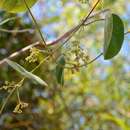Comments
provided by eFloras
The type variety
pareira, appears to be confined to America and has more cordate and less hairy leaves with somewhat shorter petioles than our variety.
The plant is very common in hedges at the foothills and up to c. 2300 m. It is a source of alkaloids like Seeprine, Bebeerine and Cissampeline. The leaves and roots are used as a cure for dyspepsia, diarrhoea, dropsy and in snake-bite. The stem yields a strong fibre.
- license
- cc-by-nc-sa-3.0
- copyright
- Missouri Botanical Garden, 4344 Shaw Boulevard, St. Louis, MO, 63110 USA
Comments
provided by eFloras
Only seven collections of Cissampelos pareira have been seen for North America, all from Dade County, Florida. It is odd that all of them had pistillate flowers. No fruiting material was observed. If staminate plants are present, they are yet to be collected.
- license
- cc-by-nc-sa-3.0
- copyright
- Missouri Botanical Garden, 4344 Shaw Boulevard, St. Louis, MO, 63110 USA
Description
provided by eFloras
A slender tomentose climber. Leaves peltate, 2.5-12 cm long, 2.5-11.5 cm broad, triangularly broad-ovate, or orbicular, obtuse, mucronate, base cordate or truncate, ± tomentose on both sides, ultimately becoming glabrous above and glaucous below; petiole pubescent. Flowers minute, pedicels filiform. Male flowers in pedunculate branched cymes, clustered in the axil of a small leaf; sepals 4, obovate-oblong, hairy outside; petals 4, united to form a 4-toothed cup, hairy outside; stamens 4, filaments united, column short, anthers connate, encircling the top of the column. Female flowers clustered in the axils of orbicular, hoary imbricate bracts, on 5-10 cm long racemes; sepal 1, ovate-oblong, pubescent outside; petal 1, obtriangular subreniform; carpel 1, densely hairy; style shortly 3-fid. Drupe 4-6 mm long, 3-4 mm broad, subglobose, compressed, hairy-pubescent, red when fresh, black when dry, endocarp transversely ribbed, tuberculate. Seeds horseshoe-shaped.
- license
- cc-by-nc-sa-3.0
- copyright
- Missouri Botanical Garden, 4344 Shaw Boulevard, St. Louis, MO, 63110 USA
Description
provided by eFloras
Vines , from thickened root. Leaves with petiole inserted to 2 mm from margin; petiole to 7.4 cm. Leaf blade 6-12 × 7-14 cm, membranous to nearly leathery; venation 7. Staminate inflorescences not seen. Pistillate inflorescences to 13 cm; bracts sessile or shortly petiolate, usually reniform, to 5 × 6 mm, grading to minute, membranous, glabrous to densely pilose. Pistillate flowers: sepals obovate, 1.2-1.4 × 0.8-1 mm; petals 4-angulate to deltate, 0.4-0.8 × 1-1.6 mm; ovary to 0.8 mm. Drupes not seen.
- license
- cc-by-nc-sa-3.0
- copyright
- Missouri Botanical Garden, 4344 Shaw Boulevard, St. Louis, MO, 63110 USA
Distribution
provided by eFloras
Distribution: India and Pakistan.
- license
- cc-by-nc-sa-3.0
- copyright
- Missouri Botanical Garden, 4344 Shaw Boulevard, St. Louis, MO, 63110 USA
Distribution
provided by eFloras
Fla.; West Indies; Central America; South America; Asia; Africa; Pacific Islands.
- license
- cc-by-nc-sa-3.0
- copyright
- Missouri Botanical Garden, 4344 Shaw Boulevard, St. Louis, MO, 63110 USA
Habitat
provided by eFloras
Hammocks and residential areas; 0-10m.
- license
- cc-by-nc-sa-3.0
- copyright
- Missouri Botanical Garden, 4344 Shaw Boulevard, St. Louis, MO, 63110 USA

